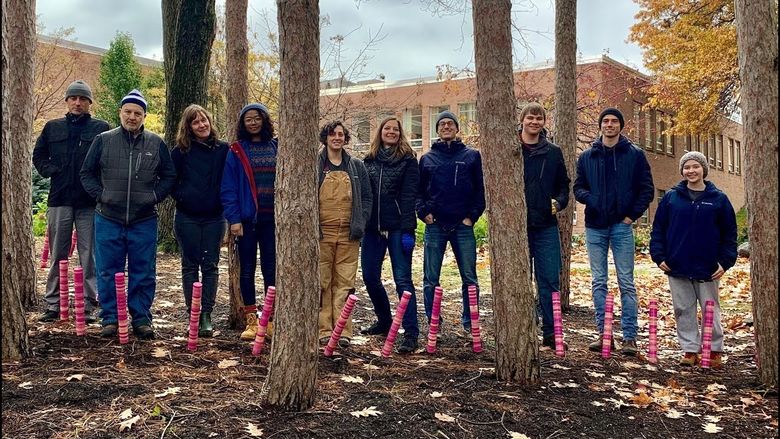
Penn State Behrend Chancellor Ralph Ford, at right, uses an iPad to explore the Zombie Ant Experience, an art installation that uses augmented reality.
ERIE, Pa. — Zombies! Ants! Parasitic fungus!
The new augmented reality project at Penn State Behrend’s School of Science complex could serve as the set for a drive-in horror movie.
It’s actually an interactive art installation, and a clever way to teach spore trajectories: Visitors step into the sculpture and are transformed, through augmented reality, into an ant, living peacefully beneath the forest canopy. They are soon attacked by a simulated fungus, which turns them into “zombie” ants. They spread the fungus to other ants, extending the life of the fungus.
The project began when David Hughes, the Dorothy Foehr Huck and J. Lloyd Huck Chair in Global Food Security at Penn State’s Department of Entomology, looked for a new way to illustrate spore trajectories in a manuscript. He reached out to Daryl Branford, director of Science-Art Initiatives at the SciArt Group at the Huck Institutes of Life Sciences.
“After seeing the data, I thought, ‘This is more than a visualization,’” Branford said. “People need to experience the data.”
He brought in Talley Fisher, a senior research artist at the SciArt Group. She used aluminum to create the metal elements of an interactive sculpture.
The biggest challenge, Fisher said, was to design ways to visualize complex scientific processes. The team used 3D animation and augmented reality to immerse visitors in a biological process.
“The physical environment allows you to feel as if you are really in a forest, with leaves above you,” Fisher said. “We use hexagons to symbolize sugars – a food source for the ants – and chemical symbols in the background that represent the pheromone the ants deposit on the paths.”
The sculpture wall is 12 feet long and more than 13 feet high. It took nearly six months to design and another four months to fabricate and install for the first exhibit, in 2018.
Since its initial run at Penn State’s University Park campus, the Zombie Art Experience has traveled the commonwealth. In the process, the sculpture also has evolved.
“The installation takes many forms, depending on the location of the project, whether in the lobby of a building or on a theater stage,” Fisher said. “When using the augmented reality application, it becomes a truly interactive experience.”
At Behrend, the sculpture makes good use of lobby of the School of Science complex, a busy hub that connects eight academic buildings.
“It becomes a piece of living, breathing art,” said Sarah Whitney, assistant director for academic administration at Behrend and an associate teaching professor of English and women’s studies. She coordinated the installation at Behrend, which will remain in place through May.
In addition to blending art and science, the installation draws on different academic disciplines, including architecture, engineering and computer science. All share a common denominator, Branford said: creativity.
“Art and science are not mutually exclusive,” he said. “By communicating science through the arts, research is more accessible and capable of reaching a wider audience.”
The Zombie Ant Experience will be open during normal business hours in Penn State Behrend’s School of Science complex through May 2022. There is no fee to independently explore the sculpture, which is open to the public, and reservations are not required. Face masks must be worn while in any building at Penn State, however, including facilities at Behrend.
Robb Frederick
Director of Strategic Communications, Penn State Behrend






